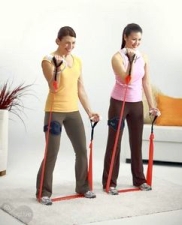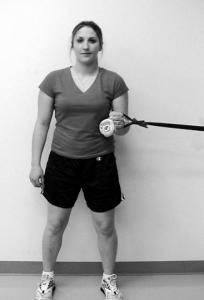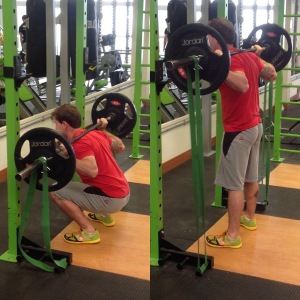Elastic Band Training Vs. Free Weight Training: What’s better?
Elastic resistance offers a variety of benefits to any training program. The use of elastic resistance can be beneficial for injury prevention, sports performance enhancement and general resistance training. Elastic resistance bands are also inexpensive and convenient. In some cases elastic resistance has been shown to elicit more muscular activation throughout resistance training. Any way you look at it, elastic resistance training is a great tool to improve the effectiveness of any exercise routine. The following article will give some general insight on how elastic band training will affect your resistance training routine.
Useful for Every Population
In my experience, elastic band training has proven useful for every population. When training my own clients, I utilized some component of elastic resistance in every session. During movement prep. Periods for my personal training clients, I will always put in some sort of light to moderate elastic resistance in for some of the smaller and intrinsic muscle groups that lie deep within injury prone areas such as the shoulder and knee joints. In my opinion, I believe every population should have a solid movement prep., period before participating in any sort of exercise. In addition, elastic bands are simple. Any population can pick one up and start doing as simple and effective exercise. For example, some people might be a little intimidated by a Squat rack. In this case, elastic bands might be a better option to start someone out on some resisted elastic band squats as opposed to jumping under a barbell in uncertainty.
Whether it be something super advanced or basic, elastic bands are not intimidating and will still serve as a useful tool to reap the benefits of resistance training. Exercise participants such as adolescent teens, athletes, geriatric and the rest of the general population can benefit from the utilization of elastic resistance training.
Add Variance to Your Exercise Routine and Work Efficiently and Effectively
The use of elastic bands is a great way to add variance to any program. For example, in between sets of a Strength and Conditioning session among athletes performing heavy lifting sessions of reps of 2-5, elastic bands can be introduced in between sets which will act as an active rest period and utilize time effectively. An example may look like this:
3 sets of 5 repetitions of the Front Squat Exercise:
- Front Squat: 5 reps
- Elastic band internal shoulder rotations (In between sets): 10 repetitions
- Front Squat: 5 reps
- Elastic band external shoulder rotations (In between sets): 10 repetitions
- Front Squat: 5 reps
- Elastic band front raise (In between sets): 10 repetitions
This is a simple example that shows how the utilization of an elastic band can be used in between a set of a compound lower body exercises as an active rest period. While the body should rest for about 2-3 minutes following a high intensity, heavy load lower body compound lift, an injury prevention technique can be inserted into the routine in between sets.
Increased Eccentric Muscle Activity
When looking at the effect on how elastic bands effect specific muscle structure, certain studies have shown that the elastic nature of certain bands can add more emphasis on the eccentric movement of muscles. The eccentric motion is the lengthening of a muscle after the shortening of the muscle, known as the concentric action. Research has shown that eccentric movements can increase muscular architecture of large muscle groups due to increased muscle damage. Increased muscle regeneration occurs after more muscle damage has been done from the more intense eccentric contraction caused by the elastic resistance. The reason that more emphasis is placed on the eccentric portion of exercising with elastic resistance is due the bulk of the resistance coming from the elasticity of the band, and not just gravity. Therefore, an additional force is acting up muscles in a different mode which is actually adding to the force of gravity during the lengthening movement of muscles throughout elastic resistance training.
Elastic Power + Gravity
While resistance training with weights is a conventional way to build strength and lean body mass, utilizing dumbbell, barbells, and resistance training machines offer the force of the weight and gravity. Elastic resistance on the other hand, offers an additional aspect of resistance, which is the elastic portion of the resistance. The stretching component of the bouncy nature of elastic resistance training equipment causes an increase in the amount of time resistance occurs in addition to the force of gravity.
In certain scenarios in my experiences as a Strength and Conditioning Coach, we have used elastic bands anchored from the ground wrapped over the top of the ends of barbells when athletes performed squats. This was meant to emphasize an extra component of resistance on top the weight of the barbell and gravity to stress the athlete’s muscles in a different nature. This technique is used to emphasize fighting through resistance at a different point of emphasis. The point of emphasis in this case was when maximum range of motion was reached on during the squat, the elastic resistance began to kick in. In the case of the barbell squat, the maximum range of motion is reached when the hips travel to their maximum length posteriorly and inferiorly to introduce an impulse of fighting through this elastic resistance at the point of maximum hip depth. Therefore, adding elastic resistance to certain exercises can give a different type of resistance that is a useful tool to increase lean body mass, strength and power at certain positions that might not be affected as significantly as standard free weight resistance training exercise alone.
Working in both Horizontal and Vertical Planes
Elastic resistance training equipment offers a certain advantage over the utilization of free weights. This advantage is that resistance is applied in both the horizontal and vertical planes of motion when utilizing elastic bands anchored at a specific point.
Let’s take the biceps curl exercise for example. Performing a curl with a dumbbell will raise the forearm toward the shoulder with the resistance of the dumbbell heading straight down along with the force of gravity. In addition, the palm of the hand and the wrist point toward the front the shoulder, which will take a significant portion of muscular activity off of the biceps and onto the traps which are holding the dumbbell up at this point. While there is muscular activity occurring on the targeted muscle group of the biceps, there is also a significant portion of the exercise in which muscular activation travels to a separate muscle group.
Now let’s look at elastic resistance anchored from the foot in a biceps curl. Resistance is not just occurring in the vertical axis, but also in the horizontal axis throughout the entire movement. Depending on where the point of resistance is being anchored from (In front, underneath, up above, behind you), elastic resistance will be introduced in these different planes of motion which will in turn lead to increased muscular stress on different sites of the muscle.
Cheaper and convenient
In addition to some of the really cool variances of exercise elastic training offers, there is one really cool benefit… THEY ARE CHEAP! One of my favorite pieces of equipment to take with me to my private personal training clients homes is the Rubber Banditz giant rubber bands. These things are worth their weight in gold. Not only do they offer a varied amount of resistance, but the sky is the limit when thinking of different exercises to satisfy the demand of what exercise needs to be accomplished. I can tie these things around anything! A post, a door knob, or under the feet of the participant, even myself. I can hold the band for them as they perform band resisted rowing exercises.
Is resistance training with weights bad? No. It’s really good. However, like I have preached before time and time again, balance is the key to gains in strength, building lean body mass and achieving fitness goals. My main point is to hit your exercise program from all angles. Don’t just stick to free weights… venture out and discover new things! This will help you grow both physically and mentally. So go add some flavor to your routines and shake it up a little with some elastic band training! It’s a great way to break a program that may become boring by introducing some good elastic resistance techniques to your exercise routine.





